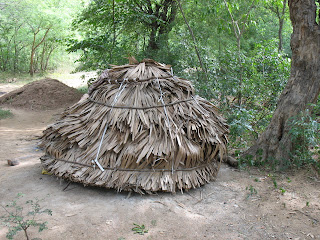Enjoy the peaceful and meditative 12 minute video below "Climbing to the Summit of Arunachala".
Showing posts with label Arunachala hill. Show all posts
Showing posts with label Arunachala hill. Show all posts
14 March 2017
18 November 2008
The Beautiful Langur Monkey
Yesterday (i.e. Monday afternoon) while visiting Temples on the south-east side of Arunachala kept a close look-0ut for the beautiful Tufted Grey Langur Monkey to point out to friends who I was showing around the Hill.
The Bonnet Macaque, of which I have written extensively in previous postings (see: Moral of the Monk, A Mother's Love, Love That Watermelon, and many others) is commonly found throughout Tiruvannamalai District and in fact in the view of some folk the Macaque is much too common and cheeky, particularly when it decides to go on scavenging hunts in residential areas by breaking into homes and raiding kitchens! Now that I live in an area not often visited by the naughty Macaque I can be more philosphical and good-natured about them and generally carry buns and snacks while performing Hill Girivalam in order to feed the Macaque Monkeys hanging about the sides of the Girivalam pathway. However I do have memories of certain incidents of maraudering naughty monkeys while I was living in a more urbanised part of Tiruvannamalai!
The below are photos I took yesterday of the beautiful Tufted Gray Langur Money. The colony was hanging about in trees feasting on leaves. They were playful and charming and continued with their romps as we were looking on.




Gray Langurs are a group of Old World monkeys made up of the genus Semnopithecus which includes:
Tufted Gray Langur
Nepal Gray Langur
Kashmir Gray Langur
Tarai Gray Langur
Northern Plains Gray Langur
Black Footed Gray Langur
Southern Plains Gray Langur
It is the Tufted Gray Langur that is found inhabitating the slopes of Arunachala specially on the south east side. All of the Langur species are largely gray with a black face. In Indian mythology, this is because Hanuman, the monkey warrior, burnt his hands and face trying to rescue Lord Rama's wife.
The Langur feeds on leaves, fruit, buds and flowers. However their diet is seasonable, with mature leaves being eaten only as a fall-back food during the winter months. In the summer, especially before the monsoon season, fruit is their chief diet supplemented with insects, tree bark and gum.
Though the Langur sleeps in trees, it spends more time on the ground and lives in medium to large groups, usually with a frequently changing dominant male.
To read more about the delightful Langur Monkey you can visit this link HERE.
26 December 2007
Preparing the Cauldron
Here are more photographs of the lighting of the 2007 Deepam on top of Arunachala. The first photograph is of pilgrims climbing the Hill to be as close to the cauldron as possible. During the next 7-10 days (the period the Deepam cauldron will be alight on Arunachala) many will make the climb to the top of the Hill to offer ghee (clarified butter) and their prayers.
[CLICK ON PHOTOGRAPHS FOR ENLARGED VERSION]
[CLICK ON PHOTOGRAPHS FOR ENLARGED VERSION]
The spectacular view of Arunachaleswarar Temple and part of the surrounding township of Tiruvannamalai, taken from near the top of Arunachala.
Lines of devotees pass along buckets, pots and all kinds of receptacles full of ghee to be poured into the cauldron.

A view from closer to the cauldron.

And now the cauldron is full of ghee and pressed on top are lengths of cotton heavily saturated with ghee. The white lumps on top of the cloth are packets of camphor. The fishermen (selected to light the cauldron) will wait until dusk and the time of lighting which will be signalled from the forecourt of Arunachaleswarar Temple down below.
21 October 2007
Saraswati Puja
Saraswati Puja, the ritual worship of the Goddess is celebrated on the fifth day of the bright fortnight of the Magha month of the Indian calendar, on the day called 'Vasant Panchami'.
Saraswati is the consort of Lord Brahma and is the Goddess of Wisdom and Knowledge. She is the personification of knowledge - arts, science, crafts and represents Shakti, creativity, inspiration and the union of power and intelligence from which organized creation arises.
Puja is performed extensively in Hindu households on the day of Saraswati. One of the most essential aspects of this puja is that one dedicates the instrument of one’s work (gardening implements for a gardener, computer for a programmer, car for a driver etc) to the Goddess on this day.
In this respect I was invited by workers associated with Arunachala Kattu Siva Plantation to their puja which was performed by a priest from Sri Ramana Maharshi at the forest location of the reforestation work of the organisation.
Saraswati is the consort of Lord Brahma and is the Goddess of Wisdom and Knowledge. She is the personification of knowledge - arts, science, crafts and represents Shakti, creativity, inspiration and the union of power and intelligence from which organized creation arises.
Puja is performed extensively in Hindu households on the day of Saraswati. One of the most essential aspects of this puja is that one dedicates the instrument of one’s work (gardening implements for a gardener, computer for a programmer, car for a driver etc) to the Goddess on this day.
In this respect I was invited by workers associated with Arunachala Kattu Siva Plantation to their puja which was performed by a priest from Sri Ramana Maharshi at the forest location of the reforestation work of the organisation.
First I have to get there so I take the very beautiful 'inner' mountain path.


Already many of the forestry workers and their families have arrived at the reforestation area, at which place the puja will take place.

Folk are busy preparing the area, and their working implements for the upcoming puja.


Subscribe to:
Posts (Atom)











